2012 Peugeot Expert Tepee ignition
[x] Cancel search: ignitionPage 51 of 276
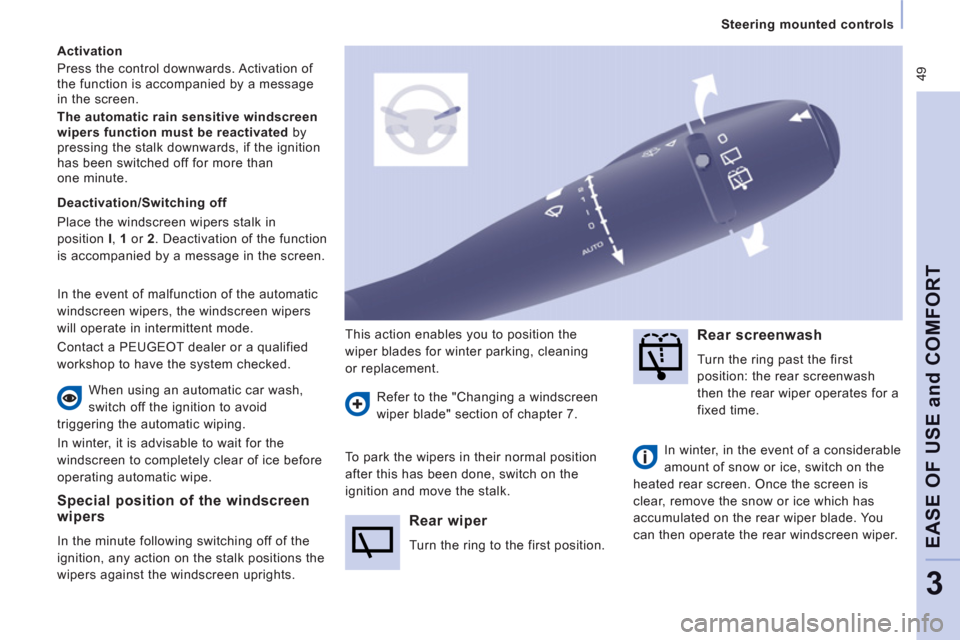
49
Steering mounted controls
EASE OF USE and COMFOR
T
3
Special position of the windscreen
wipers
In the minute following switching off of the
ignition, any action on the stalk positions the
wipers against the windscreen uprights. This action enables you to position the
wiper blades for winter parking, cleaning
or replacement.
Refer to the "Changing a windscreen
wiper blade" section of chapter 7.
To park the wipers in their normal position
after this has been done, switch on the
ignition and move the stalk. When using an automatic car wash,
switch off the ignition to avoid
triggering the automatic wiping.
In winter, it is advisable to wait for the
windscreen to completely clear of ice before
operating automatic wipe.
Rear wiper
Turn the ring to the first position.
Rear screenwash
Turn the ring past the first
position: the rear screenwash
then the rear wiper operates for a
fixed time.
In winter, in the event of a considerable
amount of snow or ice, switch on the
heated rear screen. Once the screen is
clear, remove the snow or ice which has
accumulated on the rear wiper blade. You
can then operate the rear windscreen wiper.
Activation
Press the control downwards. Activation of
the function is accompanied by a message
in the screen.
The automatic rain sensitive windscreen
wipers function must be reactivated
by
pressing the stalk downwards, if the ignition
has been switched off for more than
one minute.
Deactivation/Switching off
Place the windscreen wipers stalk in
position I
, 1
or 2
. Deactivation of the function
is accompanied by a message in the screen.
In the event of malfunction of the automatic
windscreen wipers, the windscreen wipers
will operate in intermittent mode.
Contact a PEUGEOT dealer or a qualified
workshop to have the system checked.
Page 54 of 276

52
Steering mounted controls
Switching the function off
- Place the dial in position 0
or switch off
the ignition to switch everything off.
Good practice
When changing the programmed reference
speed by means of a maintained press,
pay attention as the speed can increase
or decrease rapidly.
Do not use the cruise control on slippery
roads or in heavy traffic.
In the event of a steep slope, the cruise
control cannot prevent the vehicle from
exceeding the programmed speed.
In any event, the cruise control cannot
replace the need to observe the speed
limits, nor can it replace the need for
vigilance and responsibility on the part
of the driver.
It is advisable to leave your feet near the
pedals.
To avoid any jamming under the pedals:
- ensure that the mat and its fixings
on the floor are positioned correctly,
- never place one mat on top of another.
Operating fault
The programmed speed is cleared then
replaced by three dashes. Contact a
PEUGEOT dealer or a qualified workshop
to have the system checked. Using the accelerator:
- exceed the memorised speed until the
speed required is reached,
- press the Set +
or Set -
button.
To memorise a speed lower than the
previous one:
- press the Set -
button.
A brief press decreases the speed by 1 mph (km/h).
A maintained press decreases the speed in steps of
5 mph (km/h).
Cancelling the programmedreference speed
When the vehicle becomes stationary, after
switching off the ignition, the system no
longer memorises a speed.
FIXED SPEED LIMITER
If your vehicle is fitted with this function,
the speed of your vehicle can be limited to
a fixed speed of approximately 56, 60, 70
or 80 mph (90, 100, 110 or 130 km/h). The
fixed maximum speed cannot be changed.
The fixed speed limiter is not a function
of the cruise control type. It cannot be
activated or deactivated by the driver while
driving.
Page 57 of 276
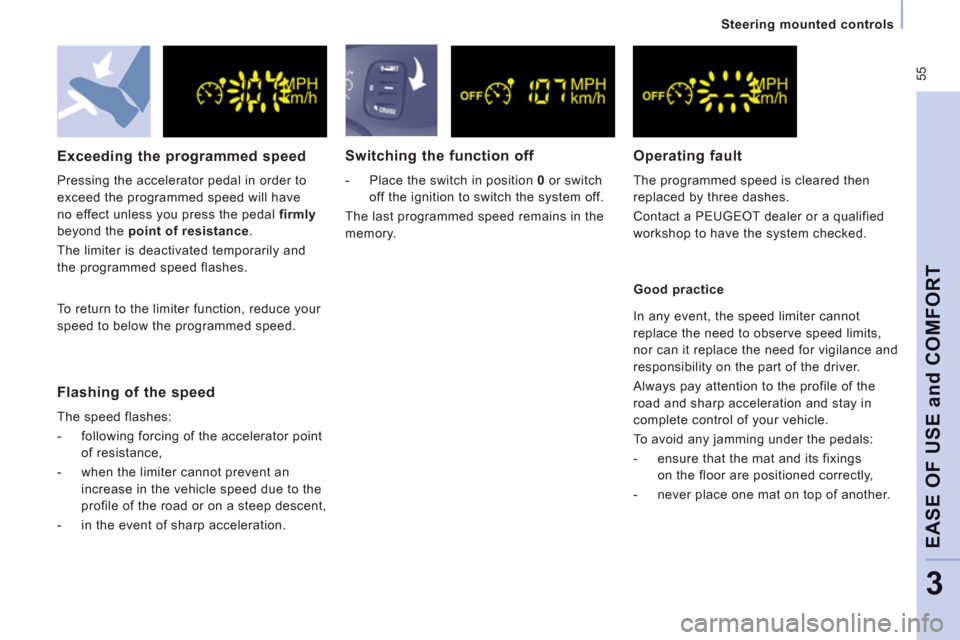
55
Steering mounted controls
EASE OF USE and COMFOR
T
3
Switching the function off
- Place the switch in position 0
or switch
off the ignition to switch the system off.
The last programmed speed remains in the
memory.
Exceeding the programmed speed
Pressing the accelerator pedal in order to
exceed the programmed speed will have
no effect unless you press the pedal firmly
beyond the point of resistance
.
The limiter is deactivated temporarily and
the programmed speed flashes.
Good practice
Operating fault
The programmed speed is cleared then
replaced by three dashes.
Contact a PEUGEOT dealer or a qualified
workshop to have the system checked.
Flashing of the speed
The speed flashes:
- following forcing of the accelerator point
of resistance,
- when the limiter cannot prevent an
increase in the vehicle speed due to the
profile of the road or on a steep descent,
- in the event of sharp acceleration.
To return to the limiter function, reduce your
speed to below the programmed speed. In any event, the speed limiter cannot
replace the need to observe speed limits,
nor can it replace the need for vigilance and
responsibility on the part of the driver.
Always pay attention to the profile of the
road and sharp acceleration and stay in
complete control of your vehicle.
To avoid any jamming under the pedals:
- ensure that the mat and its fixings
on the floor are positioned correctly,
- never place one mat on top of another.
Page 61 of 276

59
Ventilation
EASE OF USE and COMFOR
T
3
Driver or passenger side comfort value
The value indicated on the display
corresponds to a level of comfort and
not a temperature in degrees Celsius or
Fahrenheit. Automatic operation
Do not cover the sunshine sensor,
located on the windscreen behind the
mirror, it is used for regulation of the air
conditioning.
AUTO comfort programme
This is the normal air conditioning system
operating mode.
Press this button, the AUTO
symbol is
displayed.
Depending on the comfort value selected,
the system controls the distribution,
the fl ow and the intake of air to guarantee comfort
and a suffi cient circulation of air in the passenger
compartment. No further action on your part is required.
When the engine is cold, to prevent an
excessive diffusion of cold air, the ventilation
will reach its optimum level gradually.
For your comfort, the settings are stored
when the ignition is switched off and are
reinstated the next time the vehicle is
started, if the temperature in the passenger
compartment has not changed significantly;
otherwise, operation resumes in automatic
mode. Turn this control to the left or to
the right to decrease or increase
the value. A setting around the
value 21 provides optimum
comfort. However, depending on your
requirements, a setting between 18 and
24 is usual.
Page 85 of 276
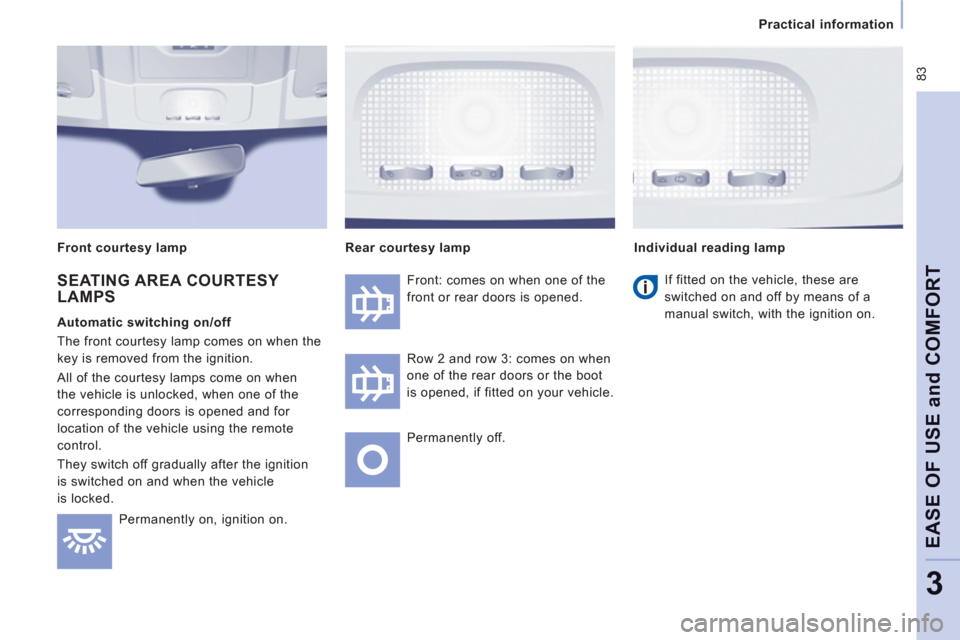
83
Practical information
EASE OF USE and COMFOR
T
3
Permanently on, ignition on. Front: comes on when one of the
front or rear doors is opened.
Row 2 and row 3: comes on when
one of the rear doors or the boot
is opened, if fitted on your vehicle.
Permanently off.
Individual reading lamp
Rear courtesy lamp
If fitted on the vehicle, these are
switched on and off by means of a
manual switch, with the ignition on.
SEATING AREA COURTESY LAMPS
Automatic switching on/off
The front courtesy lamp comes on when the
key is removed from the ignition.
All of the courtesy lamps come on when
the vehicle is unlocked, when one of the
corresponding doors is opened and for
location of the vehicle using the remote
control.
They switch off gradually after the ignition
is switched on and when the vehicle
is locked.
Front courtesy lamp
Page 86 of 276
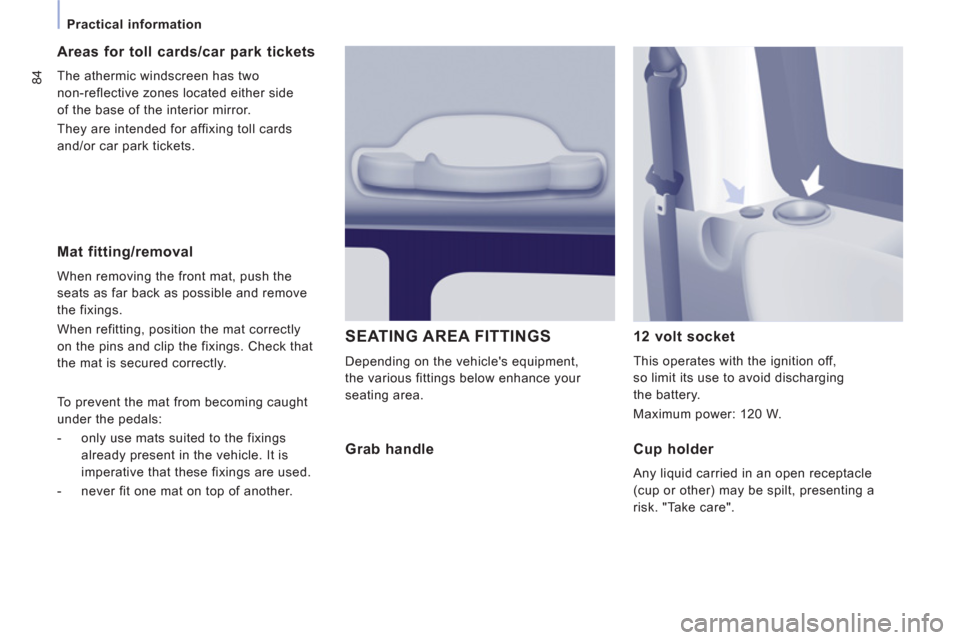
84
Practical information
Mat fitting/removal
When removing the front mat, push the
seats as far back as possible and remove
the fixings.
When refitting, position the mat correctly
on the pins and clip the fixings. Check that
the mat is secured correctly.
Areas for toll cards/car park tickets
The athermic windscreen has two
non-reflective zones located either side
of the base of the interior mirror.
They are intended for affixing toll cards
and/or car park tickets.
SEATING AREA FITTINGS
Depending on the vehicle's equipment,
the various fittings below enhance your
seating area.
12 volt socket
This operates with the ignition off,
so limit its use to avoid discharging
the battery.
Maximum power: 120 W. To prevent the mat from becoming caught
under the pedals:
- only use mats suited to the fixings
already present in the vehicle. It is
imperative that these fixings are used.
- never fit one mat on top of another.
Grab handle
Cup holder
Any liquid carried in an open receptacle
(cup or other) may be spilt, presenting a
risk. "Take care".
Page 90 of 276
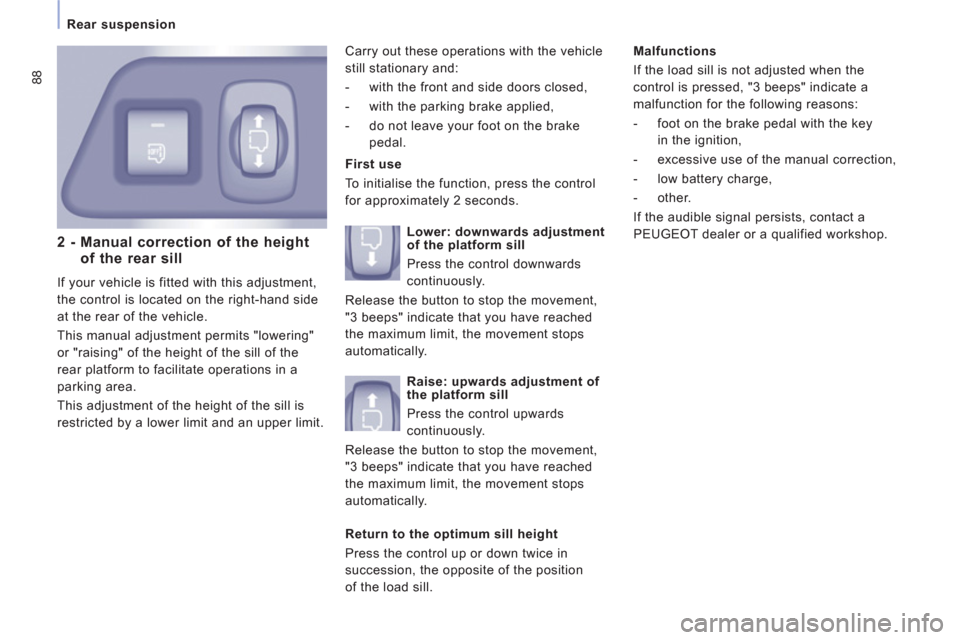
88
Rear suspension
2 - Manual correction of the height
of the rear sill
If your vehicle is fitted with this adjustment,
the control is located on the right-hand side
at the rear of the vehicle.
This manual adjustment permits "lowering"
or "raising" of the height of the sill of the
rear platform to facilitate operations in a
parking area.
This adjustment of the height of the sill is
restricted by a lower limit and an upper limit.
First use
To initialise the function, press the control
for approximately 2 seconds.
Malfunctions
If the load sill is not adjusted when the
control is pressed, "3 beeps" indicate a
malfunction for the following reasons:
- foot on the brake pedal with the key
in the ignition,
- excessive use of the manual correction,
- low battery charge,
- other.
If the audible signal persists, contact a
PEUGEOT dealer or a qualified workshop. Carry out these operations with the vehicle
still stationary and:
- with the front and side doors closed,
- with the parking brake applied,
- do not leave your foot on the brake
pedal.
Lower: downwards adjustment
of the platform sill
Press the control downwards
continuously.
Release the button to stop the movement,
"3 beeps" indicate that you have reached
the maximum limit, the movement stops
automatically.
Raise: upwards adjustment of
the platform sill
Press the control upwards
continuously.
Release the button to stop the movement,
"3 beeps" indicate that you have reached
the maximum limit, the movement stops
automatically.
Return to the optimum sill height
Press the control up or down twice in
succession, the opposite of the position
of the load sill.
Page 91 of 276
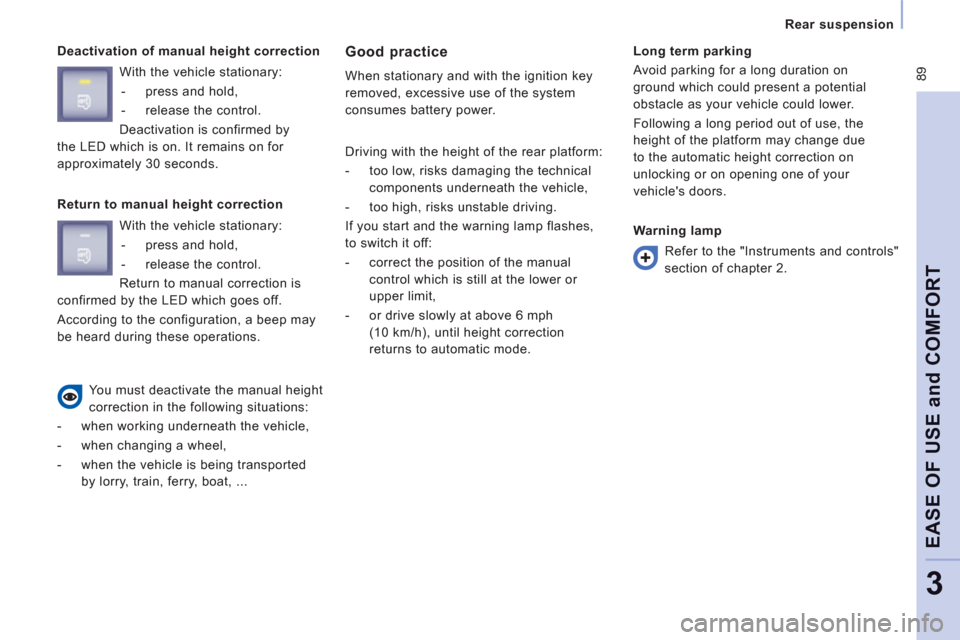
89
Rear suspension
EASE OF USE and COMFOR
T
3
Deactivation of manual height correction Good practice
When stationary and with the ignition key
removed, excessive use of the system
consumes battery power.
Long term parking
Avoid parking for a long duration on
ground which could present a potential
obstacle as your vehicle could lower.
Following a long period out of use, the
height of the platform may change due
to the automatic height correction on
unlocking or on opening one of your
vehicle's doors. With the vehicle stationary:
- press and hold,
- release the control.
Deactivation is confirmed by
the LED which is on. It remains on for
approximately 30 seconds.
Return to manual height correction
You must deactivate the manual height
correction in the following situations:
- when working underneath the vehicle,
- when changing a wheel,
- when the vehicle is being transported
by lorry, train, ferry, boat, ...
Driving with the height of the rear platform:
- too low, risks damaging the technical
components underneath the vehicle,
- too high, risks unstable driving.
If you start and the warning lamp flashes,
to switch it off:
- correct the position of the manual
control which is still at the lower or
upper limit,
- or drive slowly at above 6 mph
(10 km/h), until height correction
returns to automatic mode.
Warning lamp
Refer to the "Instruments and controls"
section of chapter 2. With the vehicle stationary:
- press and hold,
- release the control.
Return to manual correction is
confirmed by the LED which goes off.
According to the configuration, a beep may
be heard during these operations.